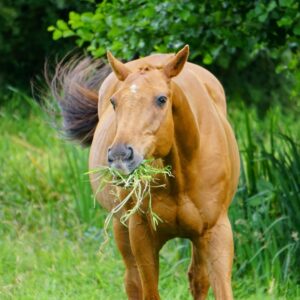 Benefits of Integrating Warm-Season Grasses into Pastures: Warm-season grasses help minimize the “summer slump” in pastures dominated by cool-season grasses such as tall fescue, orchardgrass, and Kentucky bluegrass. Specifically, warm-season grasses like Bermuda grass and crabgrass improve pasture yield in hot, dry months. Research by Rutgers University identified two additional benefits of warm-season grasses. (1) creation of desirable forage composition for certain horses, and (2) beneficial shifts in the equine intestinal microbiome.*
Benefits of Integrating Warm-Season Grasses into Pastures: Warm-season grasses help minimize the “summer slump” in pastures dominated by cool-season grasses such as tall fescue, orchardgrass, and Kentucky bluegrass. Specifically, warm-season grasses like Bermuda grass and crabgrass improve pasture yield in hot, dry months. Research by Rutgers University identified two additional benefits of warm-season grasses. (1) creation of desirable forage composition for certain horses, and (2) beneficial shifts in the equine intestinal microbiome.*
For the study, researchers followed eight metabolically normal mares (i.e., no evidence of insulin dysregulation or equine metabolic syndrome) during a single grazing season. They grazed cool-season pasture in the spring and fall. Then, warm-season pasture in the summer. Fecal samples were collected throughout the grazing season after adapting to each diet.
First Benefit:
As to the first benefit, warm-season grasses are lower in nonstructural carbohydrates (NSC) and water-soluble carbohydrates (WSC). The NSCs are composed of starch and WSCs, which are simple sugars such as glucose and fructose, among others.
Forage analysis of both warm- and cool-season grasses used in this study were similar to previous reports in that warm-season grasses had markedly lower NSCs and WSCs than cool-season grasses.
“Pastures naturally lower in nonstructural carbohydrates are particularly important for horses with insulin dysregulation because higher levels of NSCs can challenge a horse’s metabolism,” said Kathleen Crandell, Ph.D., a Kentucky Equine Research nutritionist.
According to Crandell, when excess sugars and starches are consumed, they increase blood glucose (sugar) levels, triggering the release of insulin from the pancreas. Insulin prompts the body’s tissues to take up the glucose for metabolic purposes.
“With insulin dysregulation, the glucose is not responsive to insulin’s drive to push it into the cells. This causes more insulin to be released. The horse ends up with prolonged high insulin levels in the blood. These high levels of both glucose and insulin in circulation can have detrimental effects on various metabolic functions in the body. They can potentially result in hyperinsulinemia-associated laminitis,” she explained.
Minimize Glucose Levels:
To help minimize the persistently elevated levels of circulating glucose after a meal, diets low in NSCs are recommended for horses diagnosed with insulin dysregulation or equine metabolic syndrome. With a lower NSC content, this makes the warm-season grasses desirable.
The cool-season grasses were higher in NSCs than the warm-season grasses. However, none of the horses participating in this study had abnormal results from an oral sugar test administered periodically throughout the study. The oral sugar test measures a horse’s insulin response to a sugar challenge. It is a key test used to diagnose insulin dysregulation. The researchers stated, however, the study may not have been long enough in duration to pick up on subtle changes in insulin sensitivity between horses fed warm- and cool-season grasses.
Second Benefit:
The second advantage includes microbiome shifts in response to feeding warm-season grasses.
According to the researchers, “Distinct shifts in equine fecal microbial community structure and composition occur as horses adapt to different forages within an integrated warm- and cool-season grass rotational pasture system.”
While several alterations in the intestinal microbiome were observed, one notable change was enrichment with Clostridium butyricum when consuming warm-season grasses. This bacterium is a well-known producer of butyrate, a short-chain fatty acid (volatile fatty acid).
“Butyrate promotes anti-inflammatory responses. It improves the gastrointestinal barrier to mitigate ‘leaky gut syndrome.’ It also plays a role in improving metabolic health,” Crandell explained.
“In summary, this study shows distinct benefits of feeding warm-season grasses in the summer months. For example, improved pasture yield; lower nonstructural carbohydrate levels; and enrichment in beneficial bacteria in the intestinal microbiome, specifically C. butyricum,” said Crandell.
Even with integration of warm-season grasses, all horses still benefit from a salt supplement. In addition, a high-quality vitamin and mineral supplementation to balance out the nutrients that may be low or missing in the forage.\
Resources:
Would you like more information about the Benefits of Integrating Warm-Season Grasses into Pastures? Contact us at J & J Farms by clicking here!
Article brought to you by KER.
*Weinert-Nelson, J.R., A.S. Biddle, H. Sampath, and C.A. Williams. 2023. Fecal microbiota, forage nutrients, and metabolic responses of horses grazing warm- and cool-season grass pastures. Animals (Basel) 13(5):790.

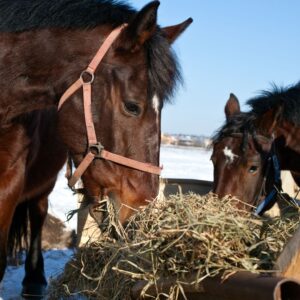 Steamed Hay for Horses: Protein Content Examined.
Steamed Hay for Horses: Protein Content Examined. 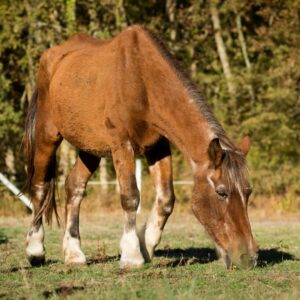 Selecting Forages for Horses Diagnosed with Equine Asthma: Environmental management is one of the most important aspects of treating and managing horses diagnosed with equine asthma. Asthma is a chronic condition that requires lifelong management changes to maintain respiratory function and overall health. Reducing exposure to respirable antigens, which are the inhaled molds, endotoxins, and other foreign matter that trigger immune response, can help alleviate the clinical symptoms of asthma. The most common respirable antigens in a horse’s environment come from hay, bedding, and potentially pasture.
Selecting Forages for Horses Diagnosed with Equine Asthma: Environmental management is one of the most important aspects of treating and managing horses diagnosed with equine asthma. Asthma is a chronic condition that requires lifelong management changes to maintain respiratory function and overall health. Reducing exposure to respirable antigens, which are the inhaled molds, endotoxins, and other foreign matter that trigger immune response, can help alleviate the clinical symptoms of asthma. The most common respirable antigens in a horse’s environment come from hay, bedding, and potentially pasture.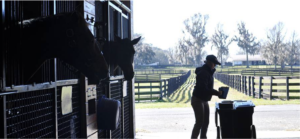 Feedstuffs for Horses: All About Beet Pulp. Fifty years ago, many knowledgeable horsemen would find it difficult to identify beet pulp or its potential value as a feedstuff for horses. Though its usefulness is now cemented among horse owners, beet pulp can still cause some confusion. Kathleen Crandell, Ph.D., a nutritionist for Kentucky Equine Research, answers eight questions about beet pulp and its role in equine nutrition.
Feedstuffs for Horses: All About Beet Pulp. Fifty years ago, many knowledgeable horsemen would find it difficult to identify beet pulp or its potential value as a feedstuff for horses. Though its usefulness is now cemented among horse owners, beet pulp can still cause some confusion. Kathleen Crandell, Ph.D., a nutritionist for Kentucky Equine Research, answers eight questions about beet pulp and its role in equine nutrition.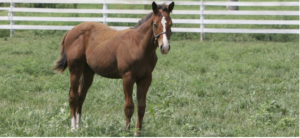 Managing Feed for Weanling and Yearling Horses: Young horses need good-quality feeds to meet their nutrient requirements for growth. In addition, free-choice exercise in large paddocks. Weanlings and yearlings have high requirements for energy, protein, amino acids and minerals in order to grow optimally. If you are using a commercial mixed feed, make sure it is formulated for the growing horse.
Managing Feed for Weanling and Yearling Horses: Young horses need good-quality feeds to meet their nutrient requirements for growth. In addition, free-choice exercise in large paddocks. Weanlings and yearlings have high requirements for energy, protein, amino acids and minerals in order to grow optimally. If you are using a commercial mixed feed, make sure it is formulated for the growing horse.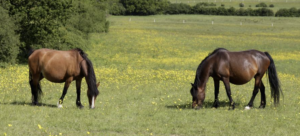 Summer Pasture-Associated Heaves: Most horse owners have heard of heaves. It’s an asthma-like condition caused by irritation of the respiratory system when dust and mold spores are inhaled. Heaves is most often found in horses that spend a lot of time in stalls. They come in contact with fine particles contained in hay.
Summer Pasture-Associated Heaves: Most horse owners have heard of heaves. It’s an asthma-like condition caused by irritation of the respiratory system when dust and mold spores are inhaled. Heaves is most often found in horses that spend a lot of time in stalls. They come in contact with fine particles contained in hay.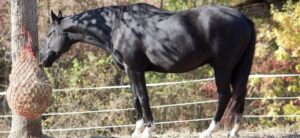 Pros and Cons of Using Haynets: New Information! For every good reason to manage a horse in a particular fashion there seems to be an equally compelling argument to not take that approach. Take haynets, for example. Haynets can be beneficial in some management scenarios. Yet a new study suggests they may increase a horse’s risk of neck or back injury.*
Pros and Cons of Using Haynets: New Information! For every good reason to manage a horse in a particular fashion there seems to be an equally compelling argument to not take that approach. Take haynets, for example. Haynets can be beneficial in some management scenarios. Yet a new study suggests they may increase a horse’s risk of neck or back injury.*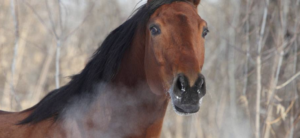 Eight Tips for Healthy Horse Lungs! Inclement weather, medical conditions, management-related issues, overstocking, and limited land. All of these factors play a role in how much time a horse spends indoors. Heaves, a condition in horses that is similar to asthma in humans. Confinement worsens it.
Eight Tips for Healthy Horse Lungs! Inclement weather, medical conditions, management-related issues, overstocking, and limited land. All of these factors play a role in how much time a horse spends indoors. Heaves, a condition in horses that is similar to asthma in humans. Confinement worsens it.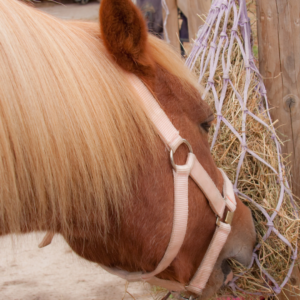 Pros and Cons of Using Haynets: New Information. For every good reason to manage a horse in a particular fashion there seems to be an equally compelling argument to not take that approach. Take haynets, for example. Haynets can be beneficial in some management scenarios. However, a new study suggests they may increase a horse’s risk of neck or back injury.*
Pros and Cons of Using Haynets: New Information. For every good reason to manage a horse in a particular fashion there seems to be an equally compelling argument to not take that approach. Take haynets, for example. Haynets can be beneficial in some management scenarios. However, a new study suggests they may increase a horse’s risk of neck or back injury.*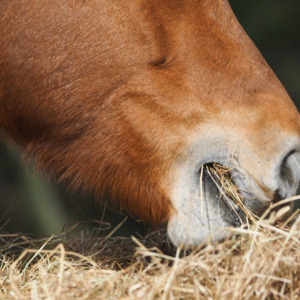 Stereotypies in Horses: New Research. Owners of
Stereotypies in Horses: New Research. Owners of